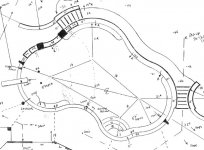First time pool owner here, and I do all my own maintenance, testing, and management. The pool as been 'online' for about 18 months, is about 40,100 gallons, and uses regular chlorine sanitation.
I use a Taylor K-2005C kit, always stored indoors and kept cool. None of my reagents are expired/past their "best by" dates, most have at least 6 months of life left.
I occasionally also take samples to Leslie's, mostly just as added insurance and confirmation, since this is my first ever pool and I want to be sure I'm doing things correctly. Their results using their machine have always been really close to the numbers I get, across the board.
Until today.
We had a tile replaced over the past few days, which meant I had to pull the water down below the tile line, and I took advantage of the opportunity to replace about a 3rd of the water to deal with a CH that had gotten too high. I'd been using calcium hypo granules for chlorine because I didn't know any better. I've now switched to 12.5% liquid for good. My water has always been gorgeous, crystal clear, and I've never gotten a Leslie's score that was less than 90% - most frequently it's been 100%.
Today I tested the water for CH after getting the pool back up to level, pump running for several hours. FC was 2, TC was 2 (I'm going to shock it tonight just because it's been awhile), pH was 7.4, TA was 120, CYA was 50 (it had gotten a little high also). CH using the Taylor kit STILL came in at 410, which bothered me. I needed to go to Leslie's anyway to stock up on 12.5% liquid so I took a sample with me. Their test report matched mine across the board, all except for CH. They reported 280, which was a surprise. I went to another Leslie's across town and had them test - same result as at the first store - all match mine except for a CH of 280. Thinking that even through they weren't expired there might have been some problem with my reagents, I bought a brand new set of the 3 CH test reagents and used them to test a fresh sample when I got back home. Same as before - 410.
So, now I'm struggling with two questions:
Which result do I trust?
Why could there be such a huge difference?
I don't expect to get EXACTLY the same results as they do, but having their measurement come back at nearly HALF of mine is more variance than there should be, I'm thinking.
I hope someone can help me understand what may be going on?
Thanks,
Rob
I use a Taylor K-2005C kit, always stored indoors and kept cool. None of my reagents are expired/past their "best by" dates, most have at least 6 months of life left.
I occasionally also take samples to Leslie's, mostly just as added insurance and confirmation, since this is my first ever pool and I want to be sure I'm doing things correctly. Their results using their machine have always been really close to the numbers I get, across the board.
Until today.
We had a tile replaced over the past few days, which meant I had to pull the water down below the tile line, and I took advantage of the opportunity to replace about a 3rd of the water to deal with a CH that had gotten too high. I'd been using calcium hypo granules for chlorine because I didn't know any better. I've now switched to 12.5% liquid for good. My water has always been gorgeous, crystal clear, and I've never gotten a Leslie's score that was less than 90% - most frequently it's been 100%.
Today I tested the water for CH after getting the pool back up to level, pump running for several hours. FC was 2, TC was 2 (I'm going to shock it tonight just because it's been awhile), pH was 7.4, TA was 120, CYA was 50 (it had gotten a little high also). CH using the Taylor kit STILL came in at 410, which bothered me. I needed to go to Leslie's anyway to stock up on 12.5% liquid so I took a sample with me. Their test report matched mine across the board, all except for CH. They reported 280, which was a surprise. I went to another Leslie's across town and had them test - same result as at the first store - all match mine except for a CH of 280. Thinking that even through they weren't expired there might have been some problem with my reagents, I bought a brand new set of the 3 CH test reagents and used them to test a fresh sample when I got back home. Same as before - 410.
So, now I'm struggling with two questions:
Which result do I trust?
Why could there be such a huge difference?
I don't expect to get EXACTLY the same results as they do, but having their measurement come back at nearly HALF of mine is more variance than there should be, I'm thinking.
I hope someone can help me understand what may be going on?
Thanks,
Rob
Last edited:





